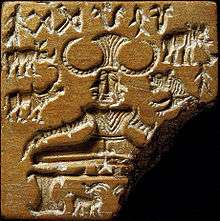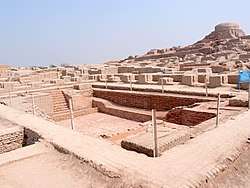Pashupati seal

| Part of a series on |
| Shaivism |
|---|
 |
|
Deities |
|
Scriptures and texts |
|
Practices |
|
Schools
Saiddhantika Non - Saiddhantika
|
|
Related
|
The Pashupati Seal is a steatite seal that was discovered at the Mohenjo-daro archaeological site of the Indus Valley Civilization. The seal depicts a seated figure that is possibly tricephalic (having three heads). It was once thought to be ithyphallic, an interpretation that is now mostly discarded. He has a horned headdress and is surrounded by animals. He may represent a horned deity.
It is purported to be one of the earliest depictions of the Hindu god Shiva ("Pashupati", meaning "lord of animals", is one of Shiva's epithets) or Rudra, who is associated with asceticism, yoga, and linga; regarded as a lord of animals; and often depicted as having three heads. The figure has often been connected with the widespread motif of the Master of Animals found in ancient Near Eastern and Mediterranean art, and the many other traditions of horned deities.[1]
Discovery and description

The seal was uncovered in 1928-29, in Block 1, Southern Portion of the DK-G Area of Mohenjo-daro, at a depth of 3.9 meters below the surface.[3] E.J.H. Mackay, who directed the excavations at Mohenjo-daro, and dated the seal to the Intermediate I Period (now considered to fall around 2350-2000 BCE) in his 1937-38 report in which the seal is numbered 420, giving it its alternate name.[4]

The seal is formed of steatite and measures 3.56 cm by 3.53 cm, with a thickness of 0.76 cm. It has a human figure at the center seated on a platform and facing forward. The legs of the figure are bent at the knees with the heels touching and the toes pointing downwards. The arms extend outwards and rest lightly on the knees, with the thumbs facing away from the body. Eight small and three large bangles cover the arms. The chest is covered with what appear to be necklaces, and a double band wraps around the waist. The figure wears a tall and elaborate headdress with central fan-shaped structure flanked by two large striated horns. The human figure is surrounded by four wild animals: an elephant and a tiger to its one side, and a water buffalo and a rhinoceros on the other. Under the dais are two deer or ibexes looking backwards, so that their horns almost meet the center. At the top of the seal are seven pictographs, with the last apparently displaced downwards for lack of horizontal space.[5][6]
Identification with proto-Shiva
Marshall's analysis
An early description and analysis of the seal's iconography was provided by archaeologist John Marshall who had served as the Director-General of the Archaeological Survey of India and led the excavations of the Indus Valley sites. In addition to the general features of the seal described above, he also saw the central figure as a male deity; as three-faced, with a possible fourth face towards the back; and, as ithyphallic, while conceding that what appeared to be the exposed phallus could instead be a tassel hanging from the waistband. Most significantly he identified the seal as an early prototype of the Hindu god Shiva (or, his Vedic predecessor, Rudra), who also was known by the title Pashupati ('lord or father of all the animals') in historic times.[7] In a 1928–29 publication, Marshall summarized his reasons for the identification as follows:
My reasons for the identification are four. In the first place the figure has three faces and that Siva was portrayed with three as well as with more usual five faces, there are abundant examples to prove. Secondly, the head is crowned with the horns of a bull and the trisula are characteristic emblems of Siva. Thirdly, the figure is in a typical yoga attitude, and Siva was and still is, regarded as a mahayogi—the prince of Yogis. Fourthly, he is surrounded by animals, and Siva is par excellence the "Lord of Animals" (Pasupati)—of the wild animals of the jungle, according to the Vedic meaning of the word pashu, no less than that of domesticated cattle.[3]
Later, in 1931, he expanded his reasons to include the fact that Shiva is associated with the phallus in the form of linga, and that in medieval art he is shown with deer or ibexes, as are seen below the throne on the seal.[7][8] Marshall's analysis of the Indus Valley religion, and the Pashupati seal in particular, was very influential and widely accepted for at least the next two generations. For instance, Herbert Sullivan, wrote in 1964 that Marshall's analysis "has been accepted almost universally and has greatly influenced scholarly understanding of the historical development of Hinduism".[9] Writing in 1976, Doris Srinivasan introduced an article otherwise critical of Marshall's interpretation by observing that "no matter what position is taken regarding the seal's iconography, it is always prefaced by Marshall's interpretation. On balance the proto-Śiva character of the seal has been accepted."[10] And Alf Hiltebeitel noted that, following Marshall's analysis, "nearly all efforts at interpreting the [Indus Valley] religion have centered discussion around [the Pashupati seal] figure".[11]
Objections and alternate interpretations
A lot of discussion has taken place about this seal.[12] While Marshall's work has earned some support, many critics and even supporters have raised several objections.[13] Doris Srinivasan has argued that the figure does not have three faces, or yogic posture, and that in Vedic literature Rudra was not a protector of wild animals.[14][15] Herbert Sullivan and Alf Hiltebeitel also rejected Marshall's conclusions, with the former claiming that the figure was female, while the latter associated the figure with Mahisha, the Buffalo God and the surrounding animals with vahanas (vehicles, mounts) of deities for the four cardinal directions.[9][16] However, Mahisha strikingly resembles Mahesha, an epithet of Shiva Pashupati, besides recalling his vehicle, or vahana Nandi, the bull. This seems to provide further evidence for the interpretation of the Pashupati seal as a proto-Shiva archetype.[17] Various interpretations have been connected to the seal, some relating it to the Vedic deities: Rudra, Agni, Mahisha, Varuna, Yogi, Yogi with Trident as head dress, Ŗșyaśŗnga (sage with horns) who is a contemporary of Dasarataand; and some non-aryan deities, including the unlikely Dravidian origin, sitting in yoga posture.[12]
Current opinion
Writing in 2002, Gregory L. Possehl concluded that while it would be appropriate to recognize the figure as a deity, its association with the water buffalo, and its posture as one of ritual discipline, regarding it as a proto-Shiva would "go too far."[18]
See also
.jpg) This plate from the Gundestrup Cauldron (200 BCE–300 AD), discovered in Denmark, probably of Gaulish or Thracian origin, depicting an antlered figure holding a serpent and a torc, flanked by animals (including a stag), and seated under, or adorned with disputed depictions of the pipal leaf is remarkably similar to the depictions on the Pashupati Seal.[19][20]
This plate from the Gundestrup Cauldron (200 BCE–300 AD), discovered in Denmark, probably of Gaulish or Thracian origin, depicting an antlered figure holding a serpent and a torc, flanked by animals (including a stag), and seated under, or adorned with disputed depictions of the pipal leaf is remarkably similar to the depictions on the Pashupati Seal.[19][20]
Notes
- ↑ Werness, Hope B., Continuum Encyclopedia of Animal Symbolism in World Art, p. 270, 2006, A&C Black, ISBN 0826419135, 9780826419132, google books
- ↑ Kenoyer, Jonathan Mark. "Mohenjo-daro: Introduction". Archived from the original on 2013-12-01.
- 1 2 Mackay & 1928-29, pp. 74-75.
- ↑ Mackay & 1937-38, plate XCIV; no. 420.
- ↑ Possehl 2002, p. 141.
- ↑ Marshall 1931, p. 52.
- 1 2 Marshall 1931, pp. 52-57.
- ↑ McEvilley, pp. 45-46.
- 1 2 Sullivan 1964.
- ↑ Srinivasan & 1975-76, p. 47.
- ↑ Hiltebeitel 2011, p. 399.
- 1 2 Bryant, Edwin, p.163
- ↑ See e. g. James G. Lochtefeld, The Illustrated Encyclopedia of Hinduism, vol. 2: N–Z. The Rosen Publishing Group, New York 2002, p. 633, who doubts the connection of the seal to Shiva, given the supposedly late age of the god.
- ↑ Srinivasan & 1975-76.
- ↑ Srinivasan 1997, p. 180-181.
- ↑ Hiltebeitel 2011, pp. 399-432.
- ↑ Chitgopekar, Nilima. Book of Durga. Penguin Books India, [2009] p. 42.
- ↑ Possehl 2002, pp. 141-144.
- ↑ Taylor, Timothy (1992), “The Gundestrup cauldron”, Scientific American, 266: 84-89. ISSN 0036-8733
- ↑ Ross, Ann (1967), “The Horned God in Britain ”, Pagan Celtic Britain: 10-24. ISBN 0-89733-435-3
References
- Hiltebeitel, Alf (2011). "The Indus Valley "Proto-Śiva", Reexamined through Reflections on the Goddess, the Buffalo, and the Symbolism of vāhanas". In Adluri, Vishwa; Bagchee, Joydeep. When the Goddess was a Woman: Mahabharata Ethnographies - Essays by Alf Hiltebeitel. BRILL. ISBN 978-90-04-19380-2.
- Mackay, Ernest John Henry (1928–29). "Excavations at Mohenjodaro". Annual Report of the Archaeological Survey of India: 67–75.
- Mackay, Earnest John Henry (1937–38). Further excavations at Mohenjo-Daro : being an official account of archaeological excavations at Mohenjo-Daro carried out by the Government of India between the years 1927 and 1931. Delhi: Government of India.
- McEvilley, Thomas (1981). "An Archaeology of Yoga". RES: Anthropology and Aesthetics. 1: 44–77. JSTOR 20166655.
- Marshall, John (1931). Mohenjo-Daro and the Indus Civilization: Being an Official Account of Archaeological Excavations at Mohenjo-Daro Carried Out by the Government of India Between the Years 1922 and 1927. Asian Educational Services. ISBN 978-81-206-1179-5.
- McIntosh, Jane (2001). A Peaceful Realm: The Rise And Fall of the Indus Civilization. Boulder: Westview Press. ISBN 0-8133-3532-9.
- McIntosh, Jane (2008). "Religion and ideology". The Ancient Indus Valley: New Perspectives. ABC-CLIO. ISBN 978-1-57607-907-2.
- Possehl, Gregory L. (2002). The Indus Civilization: A Contemporary Perspective. Rowman Altamira. ISBN 978-0-7591-1642-9.
- Srinivasan, Doris (1975–76). "The So-Called Proto-śiva Seal from Mohenjo-Daro: An Iconological Assessment". Archives of Asian Art. 29: 47–58. JSTOR 20062578.
- Srinivasan, Doris Meth (1997). Many Heads, Arms and Eyes: Origin, Meaning and Form in Multiplicity in Indian Art. Brill. ISBN 978-9004107588.
- Sullivan, Herbert P. (1964). "A Re-Examination of the Religion of the Indus Civilization". History of Religions. 4 (1): 115–125. doi:10.1086/462498. JSTOR 1061875.
- Thapar, Romila (2004). Early India: From the Origins to AD 1300. University of California Press. ISBN 978-0-520-24225-8.
- Witzel, Michael (February 2000). "The Languages of Harappa" (PDF). Electronic Journal of Vedic Studies.
- Wright, Rita P. (2010), The Ancient Indus: Urbanism, Economy, and Society, Cambridge University Press, ISBN 978-0-521-57219-4, retrieved 29 September 2013
- Bryant, Edwin (2001). The quest for the origins of vedic culture the Indo-Aryan migration debate. New York: Oxford University Press. ISBN 9780195137774. Retrieved 18 November 2014.
